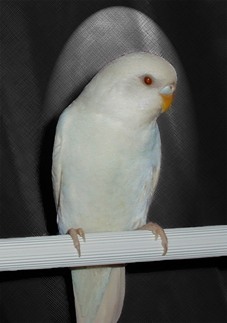Budgerigar colour genetics
Budgerigar Colour Genetics[edit | edit source]
Budgerigar colour genetics refers to the study of the genetic mechanisms that determine the wide range of colours and patterns found in budgerigars, a small parrot species native to Australia. The genetics of budgerigar colouration is a complex field involving multiple genes and alleles that interact to produce the bird's final appearance.
Basic Colour Mutations[edit | edit source]
Budgerigars exhibit two primary base colours: green and blue. The green colour is the wild type, while the blue colour is a result of a mutation. The green colour is produced by a combination of yellow pigment (psittacofulvin) and a blue structural colour. The blue mutation occurs when the yellow pigment is absent, leaving only the blue structural colour.
Green Series[edit | edit source]
The green series includes:
- Light Green
- Dark Green
- Olive Green
- Grey Green
Blue Series[edit | edit source]
The blue series includes:
- Sky Blue
- Cobalt
- Mauve
- Violet
Inheritance Patterns[edit | edit source]
Budgerigar colour genetics follows Mendelian inheritance patterns, with some traits being dominant and others recessive. The green colour is dominant over the blue colour. Therefore, a budgerigar with one green allele and one blue allele will appear green.
Dominant Mutations[edit | edit source]
- Grey: A dominant mutation that affects both green and blue series birds, resulting in grey-green or grey-blue budgerigars.
- Violet: A semi-dominant mutation that can intensify the blue colouration.
Recessive Mutations[edit | edit source]
- Ino: A recessive mutation that removes all melanin, resulting in albino (white) or lutino (yellow) birds.
- Opaline: A recessive mutation that alters the pattern of the feathers, making the bird appear lighter and more vibrant.
Combination Mutations[edit | edit source]
Budgerigars can also exhibit combination mutations, where multiple genetic factors interact to produce unique colourations. For example, a bird with both the blue and grey mutations will appear grey-blue.
Breeding for Colour[edit | edit source]
Selective breeding is commonly used to produce budgerigars with specific colour traits. Breeders must understand the genetic principles and inheritance patterns to predict the outcomes of different pairings.
Health Implications[edit | edit source]
Certain colour mutations can be linked to health issues. For example, the Ino mutation can sometimes be associated with vision problems. It is important for breeders to consider the health and well-being of the birds when selecting for specific traits.
Related Pages[edit | edit source]
Navigation: Wellness - Encyclopedia - Health topics - Disease Index - Drugs - World Directory - Gray's Anatomy - Keto diet - Recipes
Search WikiMD
Ad.Tired of being Overweight? Try W8MD's physician weight loss program.
Semaglutide (Ozempic / Wegovy and Tirzepatide (Mounjaro / Zepbound) available.
Advertise on WikiMD
WikiMD is not a substitute for professional medical advice. See full disclaimer.
Credits:Most images are courtesy of Wikimedia commons, and templates Wikipedia, licensed under CC BY SA or similar.
Translate this page: - East Asian
中文,
日本,
한국어,
South Asian
हिन्दी,
தமிழ்,
తెలుగు,
Urdu,
ಕನ್ನಡ,
Southeast Asian
Indonesian,
Vietnamese,
Thai,
မြန်မာဘာသာ,
বাংলা
European
español,
Deutsch,
français,
Greek,
português do Brasil,
polski,
română,
русский,
Nederlands,
norsk,
svenska,
suomi,
Italian
Middle Eastern & African
عربى,
Turkish,
Persian,
Hebrew,
Afrikaans,
isiZulu,
Kiswahili,
Other
Bulgarian,
Hungarian,
Czech,
Swedish,
മലയാളം,
मराठी,
ਪੰਜਾਬੀ,
ગુજરાતી,
Portuguese,
Ukrainian
Contributors: Kondreddy Naveen, Prab R. Tumpati, MD


